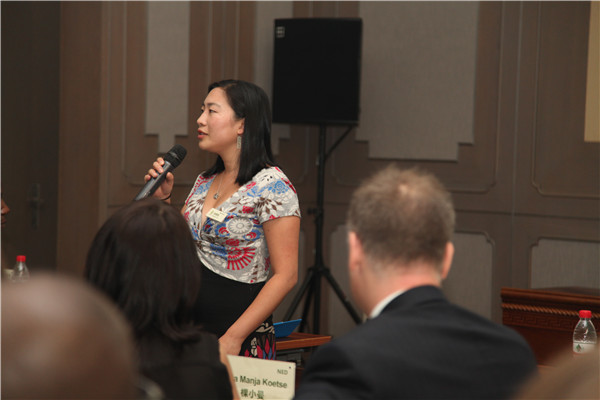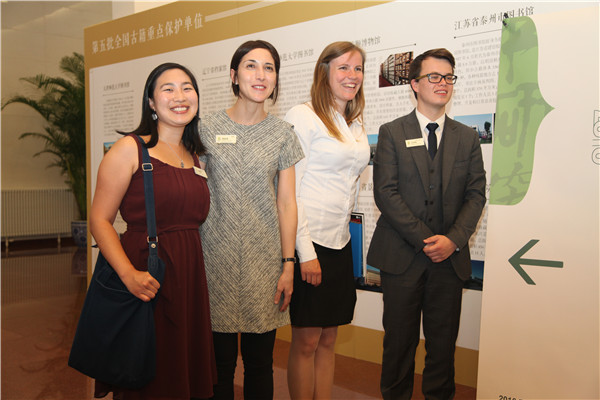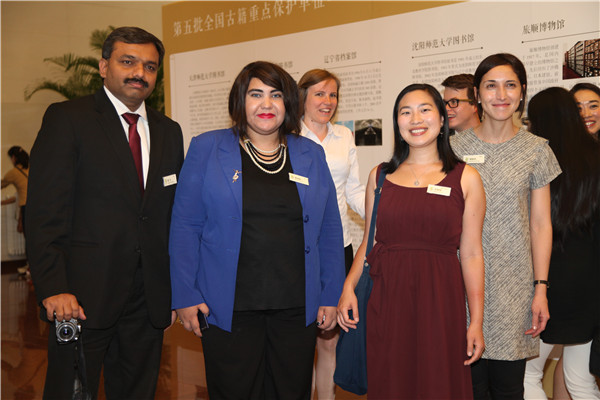
Patricia Yu speaks at the 2016 Visiting Program for Young Sinologists. [Photo/Chinaculture.org]
Patricia Yu is a PhD candidate in the History of Art department at the University of California, Berkeley in the US. She shared her story with China culture and language as she took part in the 2016 Visiting Program for Young Sinologists in Beijing. You can contact her at patriciajyu@berkeley.edu.
My primary contact with "China" has been through learning its language, its history, and its material culture. I am a heritage speaker of Chinese; when I was growing up in Los Angeles, my weekends and summers were spent in Chinese school. In college, I continued Chinese as a foreign language and majored in the history of Asia.
I wrote my undergraduate thesis on the role of clothing and fashion in China's modern political transformations from empire to republic to socialist state. My interest in Chinese art history also began during undergrad. My art history professor would always take time during class to show us actual examples of Chinese artifacts from the college museum collection.
We looked at Chinese ancestor paintings, handled delicate porcelain, and examined the symbolism of Qing dragon robes. In our student exhibitions, we learned how to structure object-based narratives. I became very interested in the material culture of China, and applied to graduate school in art history at Berkeley.

|
Patricia Yu (1st from left) visits the National Library of China during the 2016 Visiting Program for Young Sinologists. [Photo/Chinaculture.org] |
My advisor at Berkeley, Professor Pat Berger, emphasizes the importance of object-based learning. Before teaching at Berkeley, she was the curator of Chinese art at the Asian Art Museum in San Francisco. Here is a porcelain workshop that she led last year; we closely examined Chinese porcelain from the Neolithic to the end of the Qing dynasty. We not only learned about the chemical processes and materials of Chinese ceramic technology, we learned how the objects themselves testified to China's technological accomplishments and the role of international cross-cultural exchange in the development of ceramic forms.
As a graduate student at Berkeley, I also have the privilege of access to the Chinese painting collection at the Berkeley Art Museum. The museum has just re-opened in a brand-new space by the university; it now includes a study center for Chinese painting, named after professor emeritus James Cahill, who also collected paintings and donated them to the school for researchers to use. My advisor is one of his students, and I am honored to be in the same academic lineage as Prof Cahill.
The Cahill study center gives me an opportunity to learn about Chinese painting culture through actual artifacts and close looking. This picture is from earlier this year: That's me with my advisor and some visiting scholars, including a specialist in Yixing ceramics from the Palace Museum, Yu Fuchun. On the table in front of us is a Ming hand scroll, depicting the expulsion of demons from the mountains. If you look closely, you can see that the lovely ladies are actually demons in disguise.

|
Patricia Yu takes notes during a lecture as she takes part in the 2016 Visiting Program for Young Sinologists. [Photo/Chinaculture.org] |
This group photo is taken in front of hanging scrolls in the Cahill collection. They are attributed to Lin Liang, Muqi Fachang, and Shen Zhou. Prof Cahill found many of these paintings in Japan; these were styles and subjects that were not valued by Chinese literati, but were valued by Japanese collectors. So I'm actually very interested in how cultural artifacts move around the world and acquire different values over time.
That leads to my own dissertation research on cultural heritage preservation and conservation in China. When I was here in 2014, I noticed the conservation of architectural monuments in the Forbidden City and Chengde. I participated in a workshop sponsored by international conservation agencies; you can see here that we used the Yuanming Yuan ruins as a fieldwork site to demonstrate the uses of 3-D laser scanning.
From my experience in China, I decided to work on the Yuanming Yuan as my dissertation topic. It encompasses many of my research interests: Qing imperial spaces, cross-cultural exchanges (we can see this exchange happening throughout the Yuanming Yuan's history: these European Palaces were constructed by the Jesuits in the Qing court, whether or not to reconstruct the garden is also a matter of differing approaches to heritage preservation), the preservation of ruins, and expressions of cultural heritage.

|
Patricia Yu (2nd from right) poses with other participants during the 2016 Visiting Program for Young Sinologists. [Photo/Chinaculture.org] |
They do not mindlessly replicate the form of the originals, but reinterpret them for a contemporary audience. I address how cultural artifacts and cultural heritage are continuously reinterpreted and re-evaluated. I ask how reproducing cultural artifacts and places are also a form of reproducing or challenging the body of the nation.
I look forward to spending the next three weeks with such a distinguished group of interdisciplinary scholars. I'm sure I will learn a lot from each of you and I hope that we continue to be resources for each other in our professional careers.
